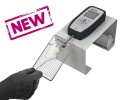Authors
C. Pin-Barre, J. Laurin, M.S. Felix, V. Pertici, F. Kober
Lab
Aix-Marseille Université, Marseille, France
Journal
PLOS One
Abstract
The purpose of the study was to highlight the acute motor reflex adaptation and to deepen functional deficits following a middle cerebral artery occlusion-reperfusion (MCAO-r). Thirty-six Sprague-Dawley rats were included in this study. The middle cerebral artery occlusion (MCAO; 120 min) was performed on 16 rats studied at 1 and 7 days, respectively (MCAO-D1 and MCAO-D7, n = 8 for each group). The other animals were divided into 3 groups: SHAM-D1 (n = 6), SHAM-D7 (n = 6) and Control (n = 8). Rats performed 4 behavioral tests (the elevated body swing test, the beam balance test, the ladder-climbing test and the forelimb grip force) before the surgery and daily after MCAO-r. H-reflex on triceps brachii was measured before and after isometric exercise. Infarction size and cerebral edema were respectively assessed by histological (Cresyl violet) and MRI measurements at the same time points than H-reflex recordings. Animals with cerebral ischemia showed persistent functional deficits during the first week post-MCAO-r. H-reflex was not decreased in response to isometric exercise one day after the cerebral ischemia contrary to the other groups. The motor reflex regulation was recovered 7 days post-MCAO-r. This result reflects an acute sensorimotor adaptation at the spinal level after MCAO-r.
BIOSEB Instruments Used:
Grip strength test (BIO-GS3)

 Douleur - Allodynie/Hyperalgésie Thermique
Douleur - Allodynie/Hyperalgésie Thermique Douleur - Spontanée - Déficit de Posture
Douleur - Spontanée - Déficit de Posture Douleur - Allodynie/Hyperalgésie Mécanique
Douleur - Allodynie/Hyperalgésie Mécanique Apprentissage/Mémoire - Attention - Addiction
Apprentissage/Mémoire - Attention - Addiction Physiologie & Recherche Respiratoire
Physiologie & Recherche Respiratoire
 Douleur
Douleur Métabolisme
Métabolisme Système moteur
Système moteur Neurodégénérescence
Neurodégénérescence Thématiques transversales
Thématiques transversales Système musculaire
Système musculaire Functions de motricité générale
Functions de motricité générale Troubles de l'humeur
Troubles de l'humeur Autres pathologies
Autres pathologies Articulations
Articulations Système Nerveux Central (SNC)
Système Nerveux Central (SNC)  Système sensoriel
Système sensoriel
